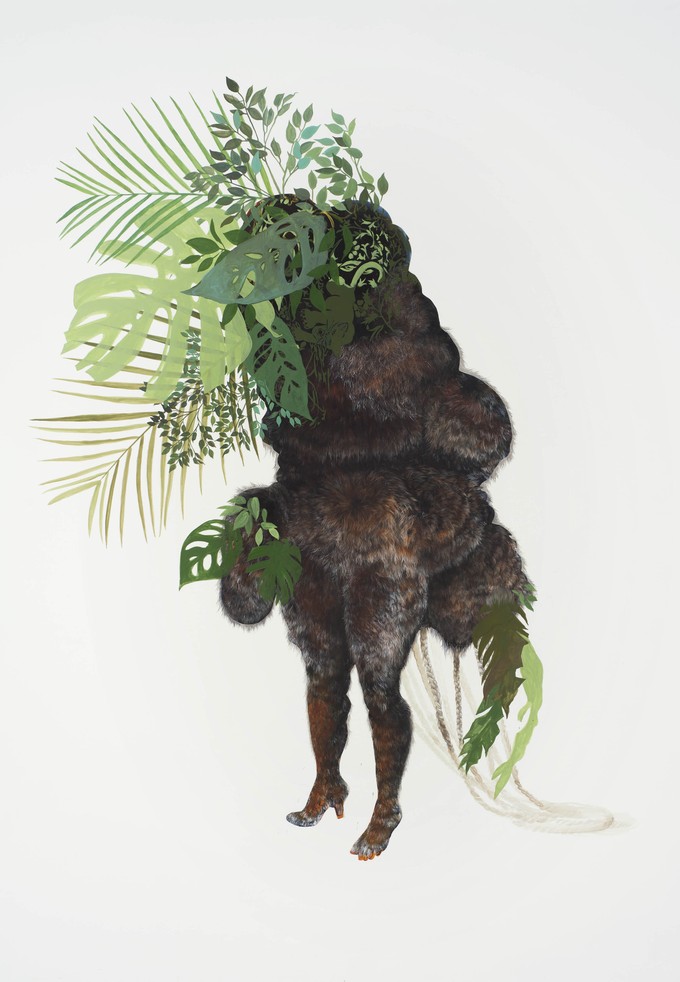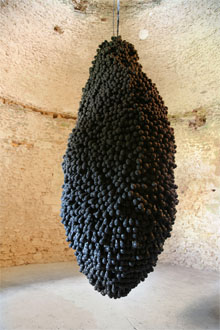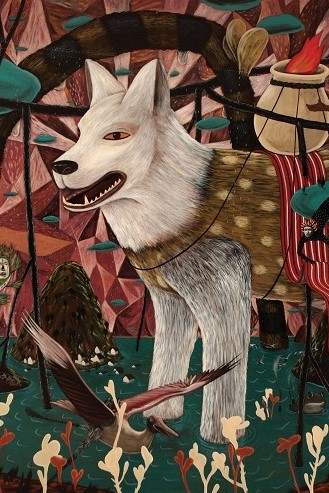Firelei Baez at "An Opera for Animals"
23.06.2019—

Image of Firelei Baez, Ciguapa Pantera (to all the goods and pleasures of this world), 2015.
We are pleased to share that Firelei Baez's artwork Ciguapa Pantera (to all the goods and pleasures of this world), 2015, will participate in the An Opera for Animals at Para Site, Hong Kong (Mar 23-Jun 9, 2019) is a prelude to a partnership with Rockbund Art Museum, Shanghai. Between Jun 22 – Aug 25, 2019 at Rockbund Art Museum, and Sep-Dec 2020 at Para Site, the two institutions will develop and present together with two related exhibitions.
About the Exhibition
“Opera” has been used as the name to describe various traditions of performance, social arrangement, entertainment, and spiritual work from around the world. Many of these are ancient and radically different from each other but are nevertheless classified as regional variants of the (relatively young) Western model. But more than being yet another example of lingering colonial taxonomy, this brings into discussion the status of opera as the highest art form, reflecting the European colonial project. There is an almost perfect chronological overlap between the golden age of Western opera and Europe’s occupation of most of the world, at the end of the 19th century and beginning of the 20th. There are, as well, the obvious cases of operas built on exotic desire like Turandot and Madama Butterfly or the case of Aida, commissioned for the inauguration of the Suez Canal. But there is more to this than just chronological coincidence.
The scale of ambition needed to imagine the absolute art form that opera was, aiming to organize every aspect and implication of the viewer’s experience, is intimately connected to that moment of absolute hubris when Europe imagined that it could dominate and reorganize the entire world. But European opera was not only a form of bourgeois entertainment, even one that was celebrating the glory of imperial conquest. These total spectacles, held in some of the grandest buildings erected in this time period—in the symbolic urban position previously occupied by cathedrals—with society neatly organised by class facing the elaborate scene on the stage, were in many ways quasi-religious experiences, where European glory was not just a subject of the performance but a collectively lived ecstatic apotheosis.
This was happening as Europe was priding itself on its modern rationality, seeing itself in opposition to the “animist” world of the peoples it was occupying at the same time. The modern view, deeply connected to the colonial project, also changed the physical, emotional, and symbolic relationship between humans and animals, elevating the status of humans, in a view radically different from many indigenous systems of knowledge and value. But European opera contained the clues exposing this charade, for it was far from its official claim of a secular spectacle, amusing a modern society. The phantoms, monsters, and sacred animals of European Empires have always haunted these opera houses, where they were sacrificed, channeled, and embodied within the great shrines of modernity.
An Opera for Animals is nevertheless interested in how these complexities are still alive, even after the demise of the colonial era and of Western opera as a fully living art form. As a parallel discussion, it includes less discussed connections between European classical music and other music systems. More extensively, the exhibition looks at different acts of staging that have been crucial to our imagination of modernity. The conflicts of staging, controlling, hiding, and repressing that occur within the operatic space are at the very core of our contemporary reality, defined by constructed and “alternative” truths, digital parallel worlds, self-staging of personal identities, and the increasingly palpable promise of a new technological turn in the field of intelligence. As such, the exhibition understands opera and related issues such as“staging” and “operatic environment” broadly, as terms describing the synthetic landscapes imagined and generated in our world today. Equally, the animal spirit connects the still very present ancient beliefs with a highly futuristic fear of new forms of irrationality and intelligence colonizing our future. The world of technology continues to draw influence from the unique characteristics of certain animal species, enforcing this connection.
This exhibition explores the way in which the future is now projected less as the rational thinking commonly remembered from the post-war era – the advanced machinery, design, and social forms – but once more as a place of amorphous fear, of animals that might take over inartificial landscapes. The future it seems will again be an opera for animals.
-- An Opera for Animals is curated by Cosmin Costinas and Claire Shea
news archive
First long term Museum loan
April 2, 2013—We are very pleased to announce our first long-term, 7 year loan, of Shilpa Gupta’s stunning work from 2010, “I Keep Falling At You”, to the ZKM.
Read More »New Auction Record: Ruben Pang at Phillips Hong Kong Day Sale, July 2020
Aug. 11, 2020—Ruben Pang, The Shredding Series, 2014
Read More »Tapaya sets new benchmark price for contemporary art in the Phillipines
June 1, 2019—Rodel Tapaya's monumental and award-winning 2010 work Cane of Kabunian, numbered but cannot be counted sets new record as the most expensive contemporary artwork sold in the Philippines, at Salcedo's June 1 "Paradise Found" auction.
Read More »


